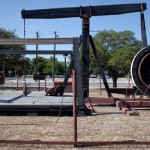A Hidden Danger of Fracking
Much of the attention to the potential dangers of oil and gas exploration, especially in hydraulic fracturing (aka “fracking”), has focused on the environmental impact it may have. Will it cause earthquakes? Can it pollute the water? Does natural gas have a bigger carbon footprint than coal?
But a new study from the Chemical Safety Board (CSB), a federal agency that investigates chemical accidents, demonstrates another, less obvious danger: teenagers.
Children and young adults frequently socialize at oil sites in rural areas, unaware of the explosion hazards from storage tanks that contain flammable hydrocarbons like crude oil and natural gas condensate. The unintentional introduction of an ignition source (such as a match, lighter, cigarette, or static electricity) near tank hatches or vents can trigger an internal tank explosion, often launching the tank into the air and killing or injuring people nearby.
Last year in the rural community of New London, Texas, an M-C Production oil tank exploded when a cigarette was lit by a couple in their mid-twenties. The exploding tank flew 48 feet away, killing the woman and seriously injuring her companion. An investigation by the CSB revealed that “at the time of the explosion the oil site had no fences or hatch locks, nor were the tanks designed to reduce the potential of an internal explosion.”
As more and more oil and gas fracking sites are developed, and as population density increases there will be more places for rural kids and teenagers to hang out, and more risk to the public. The report notes that fracking has nearly doubled from 2009 to 2010, as has the number of active wells. And 85 percent of these oil and gas wells are small, generating 15 barrels of oil a day or less.
Since 1983, 43 people have died and 25 have been injured, all under the age of 25. There have been three deadly accidents in the past two years alone. When the CSB investigated, they found that in all three cases, they “occurred in isolated, rural wooded areas at production sites that were unfenced, did not have clear or legible warning signs and did not have hatch locks to prevent access to the flammable hydrocarbons inside the tanks.”
The good news is that the accidents are “easily preventable,” according to Rafael Moure-Eraso, chairman of the CSB. “Basic security measures and warning signs – as well as more safely designed storage tanks – will essentially prevent kids from being killed in tank explosions at these sites,” he said in a statement released with the study. The CSB is calling on the Environmental Protection Agency (EPA) and state regulators to add “warning signs, full fencing, locked gates, locks on tank hatches, and other physical barriers.” And the board specifically called our regulators in Mississippi, Oklahoma, and Texas to demand that oil and gas companies use safer, newer tanks that are less likely to explode when something is ignited nearby.
The CSB produced a video about one tragic oil tank explosion in Mississippi in 2009 that killed two teenagers. It’s called “No Place to Hang Out: The Danger of Oil Sites” and is shown by educators and trainers in the state to help prevent teenagers from hanging out at oil and gas sites.
The full study:


